Navy aviators have begun a quiet but earnest threat reappraisal. “You will face an adversary who believes he can beat you, your airplane, your tactics, and your sensors,” four-star Adm. Patrick M. Walsh warned carrier pilots in late 2009.
The Navy is taking emerging threats in the Pacific seriously, and China looms large in this regard. Walsh, in fact, was intentionally repeating an identical remark voiced in 2008 by Adm. Robert F. Willard, who in October took over command of US Pacific Command.
Official statements from the Navy have begun cautiously to acknowledge a growing threat. Adm. Timothy J. Keating observed the Pacific near-peer for two years while commanding PACOM.
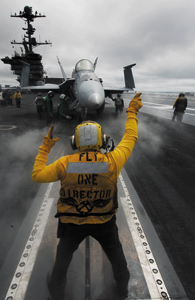 |
Petty Officer 2nd Class Raul Barrios guides an F/A-18C Hornet onto a cataput aboard the aircraft carrier USS |
“They’ve got 65-some submarines,” he said of China’s military. “They’ve got some relatively sophisticated and capable air force assets. Their defense budget is apparently growing. It is hardly transparent to us how much money they spend, much less what they’re spending that money on.”
“By the next decade, China will have more warships than the United States,” wrote Rear Adm. Terry B. Kraft in the September 2009 issue of US Naval Institute’s Proceedings.
Detailed, tactical attention to the prospect of an air battle with China has taken on new importance in the last few years.
China’s advanced aircraft, air defenses, and ballistic missiles pose a threat to carrier aircraft. Modified ballistic missiles such as the DF-21 may target carrier strike groups. A direct hit on a carrier is such a nightmare scenario that Proceedings ran an artist’s rendition of the aftermath of a missile hitting a Nimitz-class carrier as a cover illustration this year.
Yet a direct hit is not the chief scenario. Saturation attacks, to disrupt US operations, are more within China’s near-term technical reach.
Trying to launch or recover aircraft under threat of a missile barrage would be extremely taxing. The missile threat could disrupt flight deck operations or force carriers to operate farther from the shore. Like Air Force expeditionary wings, carrier air wings are very busy, but unlike the deployed Air Force wings, they don’t operate any stealth aircraft or unmanned air vehicles.
That is about to change, provided the Navy can survive Quadrennial Defense Review-driven budget cuts.
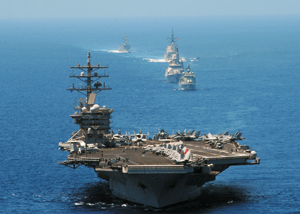 |
USS |
The Navy has several new aircraft types in the works. At a time when Air Force aviation budgets have been under siege, Navy aviation procurement—known as the APN account—is enjoying a bonanza period. Purchases of F/A-18E/F Super Hornets began in 1997 and totaled 449 by 2009. Navy aviation funding grew by $4.2 billion from Fiscal 2009 to Fiscal 2010 alone.
First flights of the Navy EA-18G Growler electronic attack fighter, the E-2D Advanced Hawkeye surveillance aircraft, and the land-based P-8 Poseidon patrol aircraft have all taken place in the last few years. Up to 68 Global Hawks modified for broad area maritime surveillance (BAMS) are on order. The combined buys for maritime surveillance of roughly 108 P-8s and up to 68 BAMS will total 176.
The stealthy F-35C carrier variant rolled out in 2009 and will begin rigorous flight tests in 2010.
Arching over all these naval airpower modernization plans is an ongoing debate about the size of the Navy’s carrier force. Eleven is the preferred number—but that force is under quiet attack.
Through the 1990s, the Navy maintained 12 carriers, but it decommissioned the conventionally powered John F. Kennedy without bringing on a replacement, bringing the fleet to 11. The Navy wants to dip briefly to 10 in 2012, but return to an ongoing posture of 11 when Gerald R. Ford is delivered in 2015.
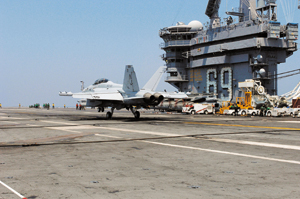 |
An EA-18G Growler conducts touch-and-go landings aboard USS |
A Little-Noticed Slow Down
The reason for the temporary drop is the need to retire USS Enterprise, the nation’s first nuclear-powered carrier. Enterprise is a unique ship with eight nuclear reactors, compared to two in the modern Nimitz-class. Enterprise was commissioned in 1961—and is more than ready for retirement. The 95,413-ton Nimitz entered service on May 3, 1975. The final ship of this class, CVN-77, George H. W. Bush, was commissioned in January 2009.
Secretary of Defense Robert M. Gates cast doubt on the long-term plan with a little-noticed April 2009 decision to slow production rates for the next generation Ford class, stretching the purchase rate from one new carrier every three years to every five years.
For now, the Navy has strong Congressional support for its 11-carrier plan. Rep. Gene Taylor (D-Miss.), who leads the House Armed Services sea power subcommittee, told Politico that he understood dropping briefly to 10 but clarified that he does “not think 10 is the proper number,” for the long term.
CVN-78, Ford, will open a new class. CVN-78 is based on the Nimitz hull but looks substantially different. The island is farther back, and electromagnetic catapults will replace 1950s-era steam-driven catapults. Ford was designed for much greater electric power generation and some reduction in crew size.
These new flattops will boast the F-35C Lightning II stealth fighter, the Growler’s electronic warfare capabilities, and advanced weapons and jamming pods tuned to defeat near-peer threats.
Currently the Navy maintains 10 carrier air wings (figuring at least one of its 11 carriers is usually in overhaul). Marine Corps squadrons often join the air wing, too.
Navy squadrons are small, with typically 12 aircraft per fighter squadron and smaller numbers for the EA-6B Prowler electronic warfare aircraft and supporting E-2s. The number of strike fighters in the air wing is the crucial variable in how many sorties each carrier can generate.
Navy plans call for keeping 44 strike fighters in each carrier air wing. Operational experience had shown that 44 worked well for the type of operations common for Iraq and Afghanistan, where commanders needed continual presence for strike and nontraditional intelligence-surveillance-reconnaissance. A Pacific scenario, of course, would require all the airpower that could be stuffed on the deck.
However, fading health of the “classic” F/A-18Cs may open a fleetwide capability gap in the middle of the next decade. Retirements could create a major shortfall in the inventory required for keeping 44 strike fighters for each of 10 air wings. The Navy is the last US customer to take delivery of the F-35, so F-35C inventories may ramp up more slowly than needed.
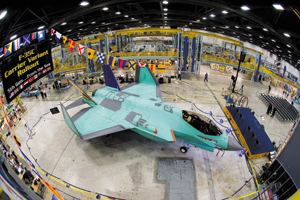 |
The Navy’s variant of the F-35 Lightning II is displayed for the rollout ceremony at Lockheed Martin’s facility in Fort Worth, Tex., in July. |
Too Big To SLEP
“At the rate we are operating these aircraft, the number of our carrier-capable strike fighters will decrease between 2016 and 2020, which will affect our air wing capacity and effectiveness,” Adm. Gary Roughead, Chief of Naval Operations, told lawmakers this summer.
The shortfall may be as large as 243 aircraft, and depends on variables such as whether the Navy opts for a service life extension plan for some Hornets.
The shortfall is “coming quicker than we anticipated a year ago,” said Rear Adm. Joseph P. Aucoin, commander of Carrier Strike Group 3.
“If the F-35C were ready now, we’d buy it,” he said. The Navy is “concerned about the gap” before the F-35 becomes operational.
A service life extension program for some classic Hornets might cost as much as $26 million per jet aircraft, according to an estimate from Ronald O’Rourke of the Congressional Research Service. An extended SLEP is truly an emergency measure—and it would not be enough.
The gap is “too big to SLEP all of it,” commented Aucoin. Another remedy under consideration is to buy more fourth generation Super Hornets, but Navy planners are adamant that they must field the stealthy, fifth generation F-35.
With the F-35C, the Navy is overcoming its distaste for stealth, an experience born out of failed efforts 20 years ago to build the stealthy A-12 attack aircraft. The cost and drama of the A-12 program left a generation of top admirals with a real antipathy toward stealth designs.
Technological advances, rising threats, and a new generation of leaders have changed that perspective. The F-35C should be—by far—the most capable carrier fighter-bomber ever built.
“The Navy really needs this airplane. This is our future,” said Cmdr. Sarah Joyner, a Navy air warfare program officer at the Pentagon. As a former F/A-18C squadron commander, Joyner was lavish in her assessment of the F-35C’s potential.
The F-35 is not a “first day only asset,” Joyner said. It is designed to fight “through sustained operations. … We have the opportunity to load it for bear and hang external ordnance,” once the F-35 has helped defeat enemy air defenses, or for strike missions in low-threat environments.
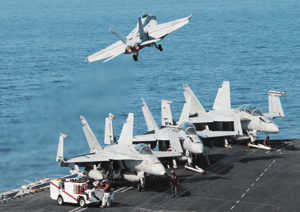 |
An F/A-18 Super Hornet launches out over the Indian Ocean from the deck of USS Nimitz in October. (USN photo by Mass Comm. Spec. 3rd Class John Philip Wagner Jr.) |
Sold on Stealth
Current plans call for a mix of F-35Cs with the nonstealth aircraft. “For me, I’m very interested in getting to the [F-35], because I like to have more than one type of airplane on an air carrier deck,” Roughead told Politico.
While the Navy is sold on stealth, the role for unmanned aircraft in carrier air wings is far from certain. Like other services, the Navy invested heavily in the 1960s generation of unmanned vehicles and didn’t like the results, and the rise of Predator as an ISR platform had no impact on naval aviation.
Earlier this decade, the Navy’s plans called for incorporating a top-line unmanned system soon after CVN-78 was delivered in 2015. Naval Aviation Vision 2020 pictured a Navy unmanned reconnaissance air system also ready in about 2015, with a strike variant scheduled for 2020. As a first step, the Navy selected Northrop Grumman to demonstrate carrier suitability for a mature unmanned combat air system in a program called N-UCAS. The Northrop Grumman aircraft has a longer wingspan than an F/A-18 Hornet and the sleek look of the B-2 bomber. It is designed for stealth and endurance. The first carrier landings may take place in 2012.
As a stealthy unmanned ISR and strike asset, N-UCAS has the potential to give carriers a unique new role in major operations. “A cornerstone to this transformation is something long missing in the carrier air wing: a capable, unmanned surveillance-strike aircraft,” wrote Thomas P. Ehrhard and Robert O. Work when both were analysts at the Center for Strategic and Budgetary Assessments. The strategic imperative is “to increase the range, persistence, and stealth of the Navy’s carrier air wing” or risk eliminating the long-term tactical relevance of future carriers. Work is now undersecretary of the Navy, and Ehrhard is a special assistant to the Air Force Chief of Staff.
The Navy is not rushing to field the system, however—cost concerns have kept aviators little more than lukewarm on the aircraft’s potential.
With no experience in operating large unmanned vehicles, N-UCAS had not been slotted into future Navy operating concepts, a fact that perhaps made it easier to ignore. “N-UCAS on carriers is kind of far out,” confirmed one expert.
Instead, Navy planners have started tossing around the idea of an unmanned system to replace the still-in-production Super Hornets. Such a system would not need to be operational until 2024, and delaying the aircraft that long would effectively take it out of current budget decisions. This is an unusual stance in a Pentagon otherwise infatuated with unmanned systems.
For all that, the Navy does have significant investment in unmanned systems. Top of the list is the Navy’s own version of the Global Hawk UAV, modified with sensors for land-based broad area maritime surveillance missions.
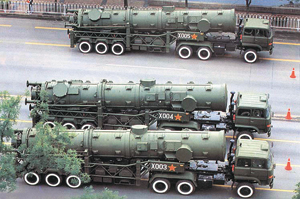 |
Chinese Dongfeng 21 missiles, such as these being transported, can be used to target carrier strike groups. A direct hit would be a nightmare. |
Other small reconnaissance UAVs, such as Scan Eagle and Fire Scout, are already in frequent use aboard the “small boys” and amphibious ships of the Navy’s surface fleet.
Here the operating concepts are more developed, and the Navy is already looking ahead to whether its new P-8 maritime patrol crews might control BAMS aircraft and share targeting data.
Improving data flow and increasing ship survivability are central to the air wing’s goals for the future, and integrating surveillance and fires was a big driver behind the new E-2D Advanced Hawkeye surveillance aircraft.
The E-2D first flew in 2007 and should enter the initial operational test and evaluation phase around 2011. Up to 70 new E-2Ds will become the core maritime airborne surveillance force. Production variants will be capable of in-flight air refueling—something no other E-2s can do.
These D models are large aircraft hosting a much-improved radar tuned to detect small objects, such as cruise missiles, against a cluttered littoral background.
Whether flying irregular warfare missions or facing near-peer threats in the Pacific, the carrier aviators of the future will be a more joint force. The days when the Navy carved out its own territory for Route Pack missions in Vietnam are far in the past, and as aviation forces contract, there’s a growing sense that the air component is in things together.
“When we pull out of Iraq and someday out of Afghanistan, it rests with our Navy and Air Force to have that forward presence overseas,” said Aucoin. “You need a strong Navy and a strong Air Force.”
| Who Has the Carriers
The international trend is favoring larger carriers—although none come near the Nimitz or Ford designs, France’s Charles de Gaulle is 24 percent larger than its predecessor, and Italy has nearly doubled its displacement tonnage with the 27,100-ton Conte di Cavour, commissioned in 2008. Britain’s pair of new carriers, to be delivered in 2015, will be three times bigger than its current flattops. Britain’s upcoming carriers Queen Elizabeth and Prince of Wales displace 65,000 tons with a ski-jump design to carry short takeoff/vertical landing F-35 variants. Part of the old Soviet fleet has been sold to India and China. India is also buying a dozen or more navalized MiG-29Ks for its carrier to be christened INS Vikramaditya. This is a significant step up in size as well. A September 2009 report announced that Russia has completed sea trials of MiGs aboard Admiral Kuznetsov, its remaining top-line carrier. China has not conducted deck operations, but it has made a big show of procuring, dry-docking, and fitting out the former Soviet-fleet Varyag from Ukraine. The nearly 10-year saga of Varyag began with the soap opera of towing the hulk from the Black Sea to the Pacific. Recently, the ship was spotted in a new dry dock decked in Chinese navy gray with an anti-skid primer on its deck. A Chinese carrier could well become a familiar silhouette in the Pacific in the next decade. |
| Where Are the Carriers
Aircraft carriers have been very active in operations over Iraq and Afghanistan. The Navy surged five carriers to bring strike fighters, E-2 Hawkeye battle managers, and helicopters to the Indian Ocean for Operation Enduring Freedom in 2001. Two carriers were deployed to the Persian Gulf to send a message to Iran in 2007. Typically, at least one carrier is on station in the North Arabian Gulf to fly sorties over Iraq or Afghanistan. F/A-18C Hornets or F/A-18E/F Super Hornets routinely fly show of force missions, drop Joint Direct Attack Munitions, and strafe enemy targets in the war zone. |
